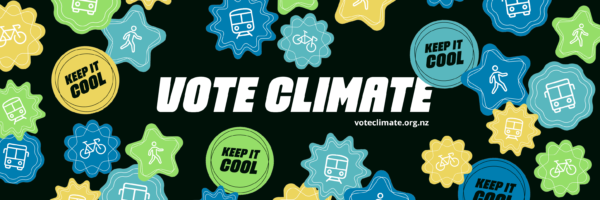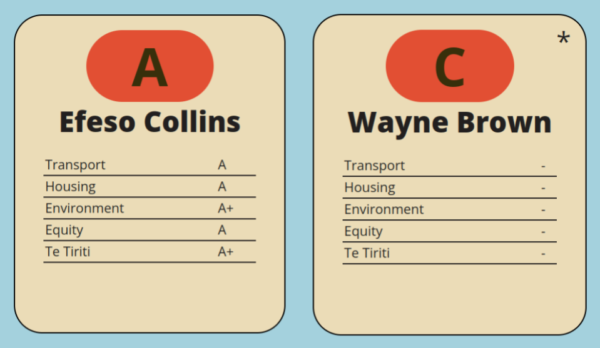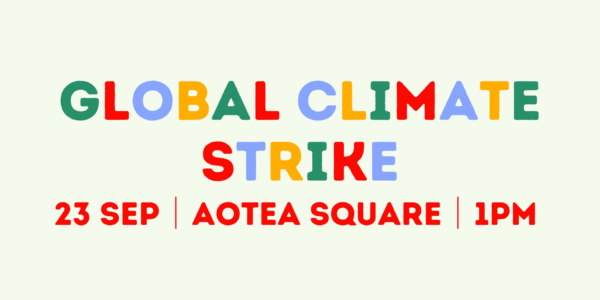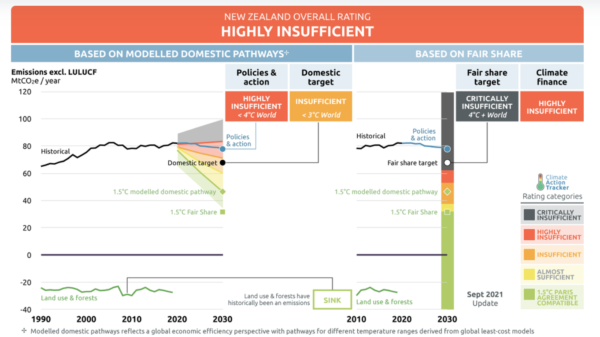It’s people who will make our city a nicer place to live, work, care, play – and move around.
People – with clever minds, holding a vision of a beautiful, thriving city.
People – whose commitment to each other creates a better home for all of us.
People in our public organisations have already shaped excellent plans for decarbonisation: Te Tāruke-ā-Tāwhiri: Auckland’s Climate Plan (TTT), and the Transport Emissions Reductions Pathway (TERP).
The late Terry Pratchett, according to a Guardian article this weekend, used to say:
Your reward for doing something good… is to do something else good.
I like that. What better reward for the people who’ve created our world-class decarbonisation plans than ensuring the plans get implemented swiftly, so they are able to help?
Unfortunately, some other people – further behind, perhaps, on their journey of understanding – are making it harder to take action. For example, the Council’s planners who gave poor advice on the climate impacts of the changes to the Auckland Unitary Plan. And those officials at Auckland Transport who are clinging onto old ways of doing things. No one should be fearful of the TERP’s fresh approach; it simply empowers us to make the changes to planning, investment and infrastructure that will shape behaviour and emissions.
What can the public do to show support for good planning, and to urge our local government to leave behind any lingering unsustainable or regressive ideas?
Vote
Voting for the local government elections has started. If you’re enrolled to vote, you’ll be getting your voting papers in the mail. It’s not too late to enrol – so please encourage everyone who’s eligible to vote to make sure they get their papers!
Council’s website says:
You can still enrol to vote but you will need to cast a special vote. See Where and how to cast a special vote.
Who is sitting around the table at Council will make a big difference to how quickly we implement the TERP.
Local board members matter too; local boards connect Council and the public, ensuring a flow of information back and forth. Local boards can facilitate healthy community discussions about the small-scale local projects that can help improve everyone’s understanding of the benefits of change. What we don’t need is local boards that hinder progress, shooting improvements down on the misinformed reckons of talkback and tabloids.
Here are two resources to help find climate-savvy candidates:

Vote Climate’s candidate page tracks positions on climate action in the transport field, and it’s already been viewed over 27,000 times since it went up last week! Vote Climate say:
We emailed 2,400+ candidates across Aotearoa and their responses are now up so check them out before you #VoteClimate this October. Heaps of people already have! If you don’t see a response from supportive candidates, please contact them to see if they have completed the survey. They can email contact@voteclimate.org.nz if they need a new link and we will send them a new one or if they would like their photo on our social media committing to the asks.
Want to know more about Vote Climate? They are on Facebook, Twitter and Instagram:

Generation Zero have put in the hard yards yet again, and are back with their helpful Vote Local scorecards. They asked questions in five different subject areas.
In terms of the two main mayoral candidates, Efeso Collins is looking good in both surveys, but it appears Wayne Brown didn’t respond.


Brown needs to engage with the issues and be transparent in his policies. It’s not too late for him to contact Vote Climate and answer their surveys. We can follow up in a Weekly Roundup post, to show his scorecard results when he has done so. This is an opportunity to show leadership to other council candidates, too.

March
Fridays for Future is a global youth-led climate activist group, which is welcoming everyone to a protest this Friday, with the message that they want:
actual climate ACTION from our leaders!
Here’s the when and where:

And here’s the why:
Fridays for Future say they recognise that government has “made steps in the right direction” – but they are demanding a much more responsible level of action. They criticise the government’s continued fossil fuel exploration, refusal to recognise the real cost of our highest emitters, and they highlight that New Zealand’s overall response to climate has been highly insufficient:

The benefits of climate action are huge – for people today as well as our children and grandchildren. Nothing is holding us back from having an “exemplary” climate response! Our health, happiness and economic future would certainly rise immediately.
Fridays for Future also raise an important point about investments by public organisations:
Through ACC and KiwiSaver investments, it pumps 1.5 billion dollars into fossil fuels.
These public entities could be investing in new climate-resilient low-carbon infrastructure like road reallocation projects for cycleways and busways, a programme of low traffic neighbourhoods, and infrastructure upgrades to enable intensification.
This is part of a wider election issue: while Auckland Council has laid out a plan for what the city needs, we need strong political will to bring all public organisations together so they are aligned. Our elected members need to advocate and negotiate on our behalf – whether the topic is land use, transport planning, or climate-aligned investment decisions.
Motivate
This Friday is great timing for a march, as we head into the local government election. Protests work like elections do – the power rests in how many actually turn up. Whoever you are, whether you’ve ever been to a protest march or not, now is the time to show up and be counted.
This election needs to be all about climate, and decarbonising transport is the biggest part of Auckland’s climate response. As the TERP says:
Auckland Council, Auckland Transport and central government agencies must take immediate action to ensure their processes are supportive of the scale of transformation required…
If Auckland is to make progress towards its emissions-reduction goals, the TERP must drive these processes.
Auckland has been severely damaged by the motorway building of the last 60 years. It’s time to move the highway engineers and road builders away from making decisions for our city. It is the TERP that should be shaping the work on our transport planning, whether at local neighbourhood level or for rapid transit projects.
Let’s vote, march, and motivate everyone we know to do the same.
Will you ask your local candidates?:
Council needs to ensure the TERP is implemented immediately, and swiftly. Will you support that in every decision you make?

 Processing...
Processing...
I fear more effort will be put in to ousting the elected officials that support such change, Onehunga has “chatter” on such a plan. With such low voter turnouts,local body elections are a bit of a lottery.
The “killing off” of the LTN trial in Onehunga, has now produced this piece of madness from AT https://at.govt.nz/about-us/have-your-say/central-auckland-consultations/mays-road-and-grey-street-onehunga-intersection-safety-improvements/
As alluded to above AT are trying to solve a safety issue at a specific site,rather than dealing with the root cause. Hopefully some holistic guidance from long sighted elected officials, can steer better decision making.
That Mays Rd and Grey St project is totally nutty. It will ease the movements through the roundabout of the very ratrunning traffic that you don’t want to favour. Neighbourhood-destroying. And yes, it stems from having no strategic, holistic overview of planning. AT has abandoned even basic street hierarchy traffic circulation planning traffic engineers were using 40 years ago.
AT, I challenge you to produce a functioning, TERP-aligned traffic circulation plan for Onehunga.
The loss of the LTR in Onehunga was really sad. As someone who lived inside the LTR it was amazing, but the majority of people weren’t prepared to sacrifice convenience for less traffic and safer streets. The local board did well to resist as long as they did.
On that roundabout, thanks Brayn I wasn’t aware and I live just down the road. To be fair that is better than what they have now. The sight lines at this intersection are terrible as cars can park right up to the corners and the road dips down towards Penrose so you never really have a clear line of sight so good to see they’re yellow lining it the whole way round and increasing the berm.
The low roundabouts are a waste of time though, it needs to be raised so it just doesn’t get run over like the one on church street otherwise what’s the point. Also might ask why the pedestrian crossing to the north is miles away and to make the white markings at the roundabout more berm to narrow it up.
I’m sure there is plenty of information to show that this particular intersection is “dangerous “, but rather than “fix” it,the better option would be to make it irrelevant. It is clearly a rat running road,roundabout will enhance its appeal as such. Something LTNs are designed to achieve.
Hopefully this low roundabout will be better than the one that was installed in Cockle Bay recently, following feedback that the originally intended pedestrian islands were not acceptable to residents (to protect kids walking to the local school).
https://at.govt.nz/media/1985642/mip1819-021c-alexander-street.pdf
This roundabout is massive for such a small street, forcing vehicles that do use it into the approaching road – frequently narrowly missing vehicles waiting on the side streets. Also quite a lot of residents just either drive straight over it, or go round it the wrong way as the drivers can’t be bothered to do the right thing (i.e. driving east along Alexander Street to enter Advene by using the north side of the roundabout, rather than doing a 270° navigation around the south of the roundabout.
The baked in entitlement of the status quo seems to have no bounds.
I sure wish AT would seek an international review of their designs. That experience you’ve had isn’t good.
To prioritise walking as per the TERP, they will need to use actual crossings instead of pretend ones, and they’ll need to be at the actual intersection instead of tucked away where it suits the car flow. To prioritise cycling as per the TERP, they will need to change the traffic circulation to make LTN’s. Of course, these changes should have happened after AT adopted VZ.
How much the traffic circulation has to change – in our aggressive driving culture – will depend on whether drivers will share the road and respect the rules. And that will depend on the Police and AT rediscovering what enforcement means. If they remain missing in action, the traffic circulation is going to have to be significantly changed to provide hard engineering to separate bikes and cars.
Why can’t we vote directly for board members on AT. Cut out the middle man.
While I agree that there’s LOTS of problems with the AT board, adding even more people to vote for is not a panacea. I mean, we already have elections for things like health boards, with very low participation. I doesn’t necessarily do anything for education, can be gamed, and detracts from what they should be doing (do you really want AT board members to also look at having to gaining votes? You could get some really nutty people – not sure that’s better than the current crop of “hands off the status quo” sleepers they have).
Nah, we already vote for people. They are called Councillors, and Mayors (and to a lesser degree, Local Board members). We need to make sure AT is forced to do more what those people we elected to make the calls say.
The reward for the officials who crafted and the politicians who supported the TERP is to do something else good: https://quietskywaiheke.nz/2022/09/19/including-helicopters-in-the-terp/
That’s good.
The post mentions ACC and KiwiSaver investments as funding fossil fuels.
More positively, the NZ Super Fund has recently moved $25bn into lower-carbon investments, having undertaken assessments of performance and risk: https://www.interest.co.nz/public-policy/117608/fund-established-help-out-nz-future-pension-requirements-confident-its
Also, there are low-carbon/positive-impact KiwiSaver fund options for people choose.
Cool, goes some way to undoing the damage that was done with the Light Rail proposal getting rail-roaded – or not, as the case may be.
Excellent piece on what unfolded yesterday: https://thespinoff.co.nz/society/20-09-2022/how-one-broken-underpass-represents-everything-that-is-wrong-with-auckland